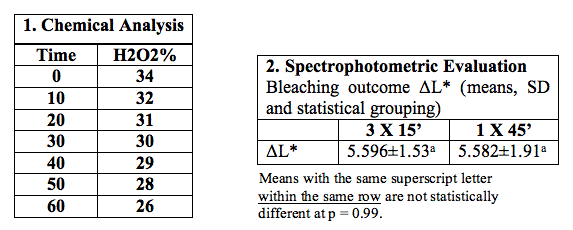ABSTRACT: 1027
In-Office Bleaching Gel-Application Time Evaluation (3x15min X 1x45min) : Pilot studies
| F.C. MARSON1, L.G. SENSI2, H. STRASSLER2, L. MIRAZIZ2, and H. RIEHL3, 1Uningá Dental School, Maringá, Brazil, 2University of Maryland Dental School, Baltimore, USA, 3H.R.B. USP, Bauru, Brazil | |
Objectives: The traditional technique for in-office bleaching includes 3 applications of the whitening gel (15 minutes each) for a total of 45 minutes. The purpose of these pilot studies was to evaluate the possibility for in-office bleaching by applying a single layer of whitening gel and leaving it in contact with teeth for 45 minutes straight. Methods: 1) Chemical Analysis: an in-vitro analysis was conducted to quantify the amount of hydrogen peroxide (HP) in function of the time elapsed. A 35% HP gel was assayed through a potassium permanganate titration method. The concentration of active HP was measured immediately after gel mixing and after 10, 20, 30, 40, 50 and 60 minutes. 2) In-Vitro Spectrophotometric Evaluation: 5 recently extracted teeth had their facial and lingual surfaces separated with a light-cured gingival barrier. One randomly assigned surface was bleached for 45 minutes straight and on the other one the gel was reapplied every 15 minutes (3X). Color coordinates (L*a*and b*) were measured with a spectrophotometer (CM2600-Minolta) and the bleaching outcome was evaluated by means of ΔL* calculation and one-way ANOVA analysis. Results: are described on the tables below. After 50 minutes only 6% of hydrogen peroxide was lost. No significant differences were observed for the spectrophotometric evaluation. Conclusions: Although further research is indicated to confirm these findings, IT SEEMS POSSIBLE TO MODIFY THE "IN-OFFICE" BLEACHING TECHNIQUE BY CONDUCTING A ONE-TIME, 45 MINUTES LONG, GEL APPLICATION.
| |
| Seq #110 - Clinical and Experimental Evaluation of Bleaching 3:30 PM-4:45 PM, Thursday, July 3, 2008 Metro Toronto Convention Centre Exhibit Hall D-E | |
|
Back to the Dental Materials 4: Clinical Trials, Biocompatibility and Biologic Effects Program | |
©Copyright 2008 American Association for Dental Research. All Rights Reserved.
